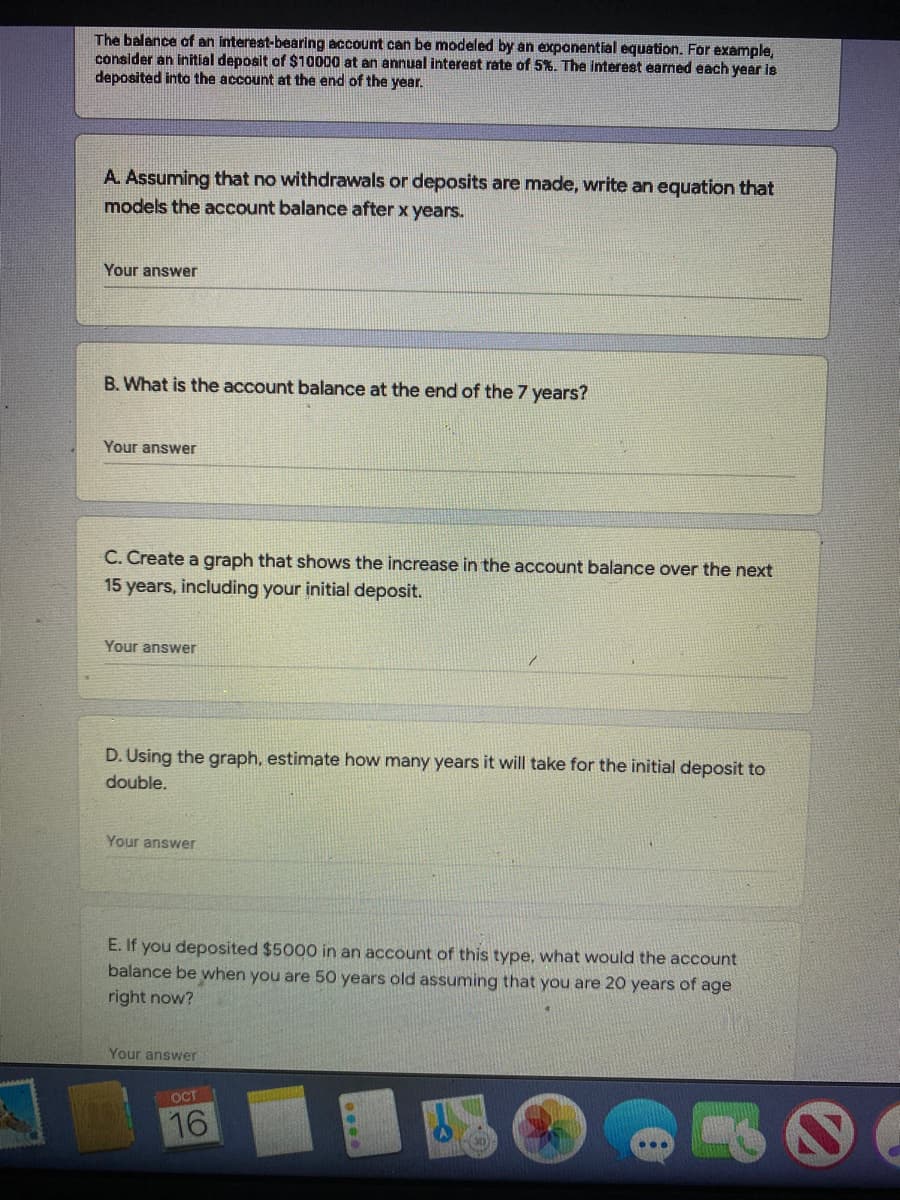The balance of an interest-bearing account can be modeled by an exponential equation. For example, consider an initial deposit of $10000 at an annual interest rate of 5%. The interest earned each year is deposited into the account at the end of the year. A. Assuming that no withdrawals or deposits are made, write an equation that models the account balance after x years. Your answer B. What is the account balance at the end of the 7 years? Your answer C. Create a graph that shows the increase in the account balance over the next 15 years, including your initial deposit. Your answer
The balance of an interest-bearing account can be modeled by an exponential equation. For example, consider an initial deposit of $10000 at an annual interest rate of 5%. The interest earned each year is deposited into the account at the end of the year. A. Assuming that no withdrawals or deposits are made, write an equation that models the account balance after x years. Your answer B. What is the account balance at the end of the 7 years? Your answer C. Create a graph that shows the increase in the account balance over the next 15 years, including your initial deposit. Your answer
Chapter11: Capital Budgeting Decisions
Section: Chapter Questions
Problem 3PB: Use the tables in Appendix B to answer the following questions. A. If you would like to accumulate...
Related questions
Question

Transcribed Image Text:The balance of an interest-bearing account can be modeled by an exponential equation. For example,
consider an initial deposit of $10000 at an annual interest rate of 5%. The interest earned each year is
deposited into the account at the end of the year.
A. Assuming that no withdrawals or deposits are made, write an equation that
models the account balance after x years.
Your answer
B. What is the account balance at the end of the 7 years?
Your answer
C. Create a graph that shows the increase in the account balance over the next
15 years, including your initial deposit.
Your answer
D. Using the graph, estimate how many years it will take for the initial deposit to
double.
Your answer
E. If you deposited $5000O in an account of this type, what would the account
balance be when you are 50 years old assuming that you are 20 years of age
right now?
Your answer
OCT
16
Expert Solution
This question has been solved!
Explore an expertly crafted, step-by-step solution for a thorough understanding of key concepts.
This is a popular solution!
Trending now
This is a popular solution!
Step by step
Solved in 3 steps with 1 images

Knowledge Booster
Learn more about
Need a deep-dive on the concept behind this application? Look no further. Learn more about this topic, finance and related others by exploring similar questions and additional content below.Recommended textbooks for you

Principles of Accounting Volume 2
Accounting
ISBN:
9781947172609
Author:
OpenStax
Publisher:
OpenStax College


EBK CONTEMPORARY FINANCIAL MANAGEMENT
Finance
ISBN:
9781337514835
Author:
MOYER
Publisher:
CENGAGE LEARNING - CONSIGNMENT

Principles of Accounting Volume 2
Accounting
ISBN:
9781947172609
Author:
OpenStax
Publisher:
OpenStax College


EBK CONTEMPORARY FINANCIAL MANAGEMENT
Finance
ISBN:
9781337514835
Author:
MOYER
Publisher:
CENGAGE LEARNING - CONSIGNMENT

Excel Applications for Accounting Principles
Accounting
ISBN:
9781111581565
Author:
Gaylord N. Smith
Publisher:
Cengage Learning

Financial Accounting: The Impact on Decision Make…
Accounting
ISBN:
9781305654174
Author:
Gary A. Porter, Curtis L. Norton
Publisher:
Cengage Learning

Intermediate Accounting: Reporting And Analysis
Accounting
ISBN:
9781337788281
Author:
James M. Wahlen, Jefferson P. Jones, Donald Pagach
Publisher:
Cengage Learning